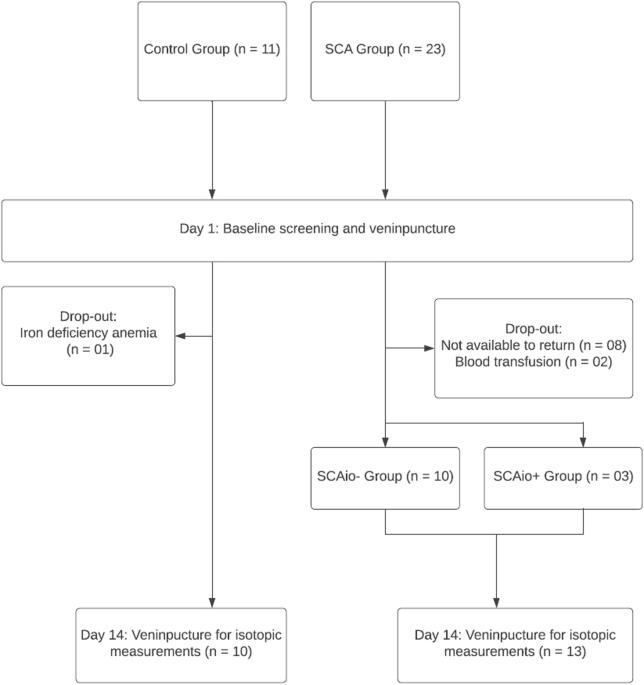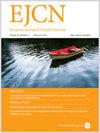小儿镰状细胞性贫血红细胞中的铁结合:稳定同位素试验研究。
IF 3.3
3区 医学
Q2 NUTRITION & DIETETICS
引用次数: 0
摘要
背景/目的:镰状细胞性贫血(SCA)以缺氧、炎症和继发性铁超载(IO)为特征,这些因素可能会调节铁稳态的关键激素--血红素。目的是评估 SCA 儿童患者红细胞(RBC)中的铁结合情况,同时考虑是否存在 IO:SCA儿童(n = 12;SCA总计)口服稳定铁同位素(57Fe),14天后测量红细胞中的铁结合率。血清铁蛋白≥1000纳克/毫升的患者被认为存在IO(SCAio+;n = 4),而其他患者被归类为无IO(SCAio-;n = 8)。肝脏铁浓度(LIC)通过磁共振成像(MRI)T2*法测定:结果:SCAio+ 组的铁结合率(平均值 ± SD:0.166 ± 0.04 mg;3.33 ± 0.757%)低于 SCAio- 组(0.746 ± 0.303 mg;14.9 ± 6.05%)(P = 0.024)。组间肝素无差异。铁结合率与血清铁蛋白水平成反比(SCAtotal 组:r = -0.775,p = 0.041;SCAio- 组:r = -0.982;p = 0.018),镰状血红蛋白(HbS)与 SCAio- 组的铁结合率呈正相关(r = 0.991;p = 0.009)。LIC 与铁蛋白(SCAtotal:r = 0.921;p = 0.026)和 C 反应蛋白(SCAio+:r = 0.999;p = 0.020)呈正相关:SCAio+组在红细胞中的铁结合率低于SCAio-组,这表明他们可能不需要像通常建议的那样减少富含铁的食物的摄入量。相反,高比例的 HbS 可能会间接加剧缺氧,并似乎会增加铁在红细胞中的结合:本试验已在 www.ensaiosclinicos.gov.br 注册。标识符:RBR-4b7v8pt。本文章由计算机程序翻译,如有差异,请以英文原文为准。


Iron incorporation in red blood cells of pediatric sickle cell anemia: a stable isotope pilot investigation
Sickle cell anemia (SCA) is marked by hypoxia, inflammation, and secondary iron overload (IO), which potentially modulate hepcidin, the pivotal hormone governing iron homeostasis. The aim was to evaluate the iron incorporation in red blood cells (RBC) in SCA pediatric patients, considering the presence or absence of IO. SCA children (n = 12; SCAtotal) ingested an oral stable iron isotope (57Fe) and iron incorporation in RBC was measured after 14 days. Patients with ≥1000 ng/mL serum ferritin were considered to present IO (SCAio+; n = 4) while the others were classified as being without IO (SCAio−; n = 8). Liver iron concentration (LIC) was determined by Magnetic Resonance Imaging (MRI) T2* method. The SCAio+ group had lower iron incorporation (mean ± SD: 0.166 ± 0.04 mg; 3.33 ± 0.757%) than SCAio− patients (0.746 ± 0.303 mg; 14.9 ± 6.05%) (p = 0.024). Hepcidin was not different between groups. Iron incorporation was inversely associated with serum ferritin level (SCAtotal group: r = −0.775, p = 0.041; SCAio− group: r = −0.982; p = 0.018) and sickle hemoglobin (HbS) presented positive correlation with iron incorporation (r = 0.991; p = 0.009) in SCAio− group. LIC was positively associated with ferritin (SCAtotal: r = 0.921; p = 0.026) and C reactive protein (SCAio+: r = 0.999; p = 0.020). SCAio+ group had lower iron incorporation in RBC than SCAio− group, suggesting that they may not need to reduce their intake of iron-rich food, as usually recommended. Conversely, a high percentage of HbS may indirectly exacerbate hypoxia and seems to increase iron incorporation in RBC. This trial was registered at www.ensaiosclinicos.gov.br . Identifier RBR-4b7v8pt.
求助全文
通过发布文献求助,成功后即可免费获取论文全文。
去求助
来源期刊
CiteScore
10.60
自引率
2.10%
发文量
189
审稿时长
3-6 weeks
期刊介绍:
The European Journal of Clinical Nutrition (EJCN) is an international, peer-reviewed journal covering all aspects of human and clinical nutrition. The journal welcomes original research, reviews, case reports and brief communications based on clinical, metabolic and epidemiological studies that describe methodologies, mechanisms, associations and benefits of nutritional interventions for clinical disease and health promotion.
Topics of interest include but are not limited to:
Nutrition and Health (including climate and ecological aspects)
Metabolism & Metabolomics
Genomics and personalized strategies in nutrition
Nutrition during the early life cycle
Health issues and nutrition in the elderly
Phenotyping in clinical nutrition
Nutrition in acute and chronic diseases
The double burden of ''malnutrition'': Under-nutrition and Obesity
Prevention of Non Communicable Diseases (NCD)

 求助内容:
求助内容: 应助结果提醒方式:
应助结果提醒方式:


